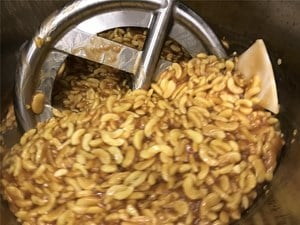Sign up to be notified of our new blog posts.
Why Mixing is So Vital to Organic Food Processing Operations
Posted on June 30, 2021

Summary: Organic food processors go to great lengths to ensure authenticity in their products. But if your end-product lacks the homestyle texture expected of fresh and natural ingredients, then that effort may be wasted. Here's how the role of mixing contributes to keeping organic food as appealing as possible:
Organic food processors go to great lengths to ensure authenticity in their products. From verifying the organic integrity of their supply chain to documenting how they prevent contamination and comingling, processors must continually prove their veracity. But if their end-product lacks the slices, chunks and homestyle texture expected of fresh and natural ingredients, then the extra effort and cost to comply with organic certification could go for naught. The reality is, if it doesn’t look organic, consumers may not buy it.
That is why Mixing is such an essential consideration for organic food manufacturers. Ideally, delicate ingredients like fresh-cut fruits or vegetables will maintain their integrity throughout the mixing and cooking process and hold their natural presentation. When these ingredients get damaged or break down while mixing and cooking, the finished product can lose some of its authentic appeal.
It is relatively easy to control mixing quality at manual or small-scale production levels. But as production volume increases, so too does the need for the proper equipment to achieve effective organic mixing.
The Challenge: Mixing at Scale Without Damaging Delicate Ingredients
Processing equipment engineers began addressing this challenge in the late 1980s, when Lee Industries introduced hemispherical kettles with inclined agitation. The engineers discovered that, compared to taller vertical tanks, less downward batch pressure is exerted on ingredients in shallower hemispherical kettles.
Then, by pairing the hemispherical kettle with an inclined agitator – usually at 45-degrees but varying based on the product -- they were able to achieve a gentle lifting and folding action that kept all the ingredients evenly suspended in the batch. This produced more consistent cooking results and eliminated the potential for damage to the fresh-cut ingredients.
Common Pitfalls with Vertical Tanks or Horizontal Blenders
As demand for their products grew, organic processors found other mixing and cooking equipment, like vertical tanks and horizontal blenders, were often less productive and efficient for products that truly showcase their natural ingredients:
- During mixing operations in vertical tanks, for example, the heavier ingredients in the batch tended to move to the bottom, where the weight of the large mass of water and other ingredients higher in the tank would compress or break down the more delicate food ingredients at the bottom of the tank.
- Similarly, when using a horizontal blender, it was difficult to hold such ingredients in suspension, causing some to float on the surface or sink to the bottom during mixing and cooking.
Why Hemispherical Kettles Work
Conversely, kettles with a hemispherical profile allowed agitator blades and scrapers to perfectly follow the curved sidewall, so that ingredients were constantly and uniformly circulated from the kettle’s interior surface, with no dead zones. When the agitator was also inclined, ingredients could be lifted and turned, gently moving solid and chunk-like ingredients from the bottom of the kettle to the top.
This unique configuration made it possible to keep key ingredients intact and assure uniform consistency from batch to batch, even in large volumes.
Other Points of Impact for Organic Production
Beyond protecting key ingredients from damage during mixing and cooking, a hemispherical kettle offers other value to organic processors:
Its sloped sidewalls provide a natural path for the batch to flow to the bottom outlet for more efficient unloading and transfer
Because the inclined agitator conforms to the hemispherical profile, scraper blades can reach the entire jacketed area, fully moving the batch toward discharge and maximizing product yield – a value, given the high cost of organic ingredients.
There is a good reason most organic foods are merchandised in see-through packaging like glass, rather than in cans or tubes. Before they buy, consumers want to match a product’s look with its claims for natural and authentic ingredients. For organic food processors, making certain that happens consistently from batch to batch, efficiently and at scale, requires the right mixing equipment.
Need Help with Organic Mixing Challenges?
If you’d like help thinking through your organic food processing needs, let us know. Our engineers will be happy to discuss your situation.
Last Updated: 11/12/2025
Comments
Add Your Own Comment